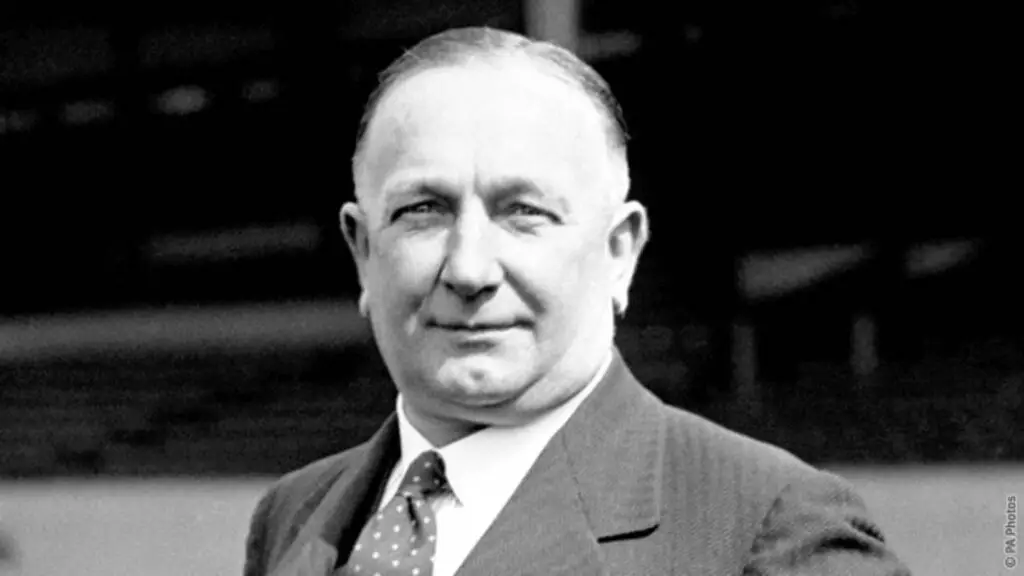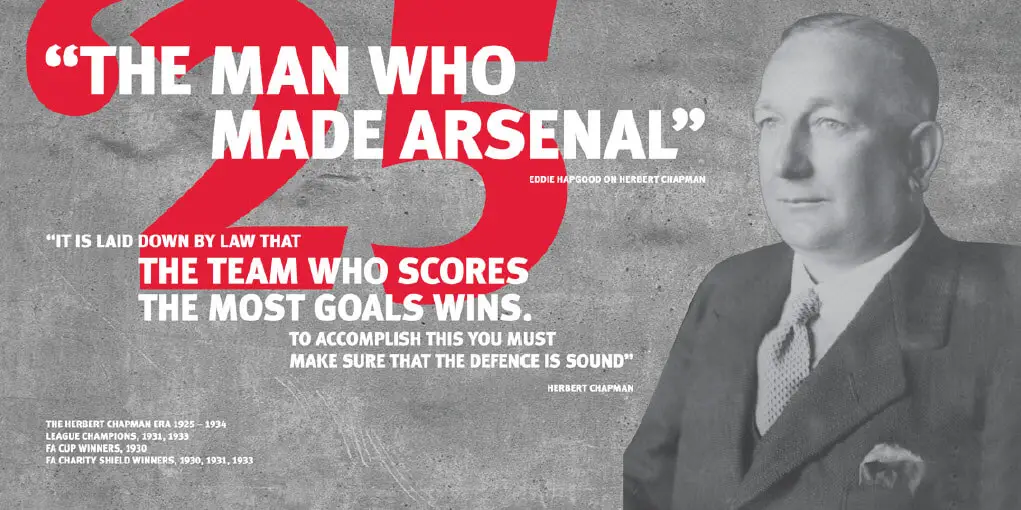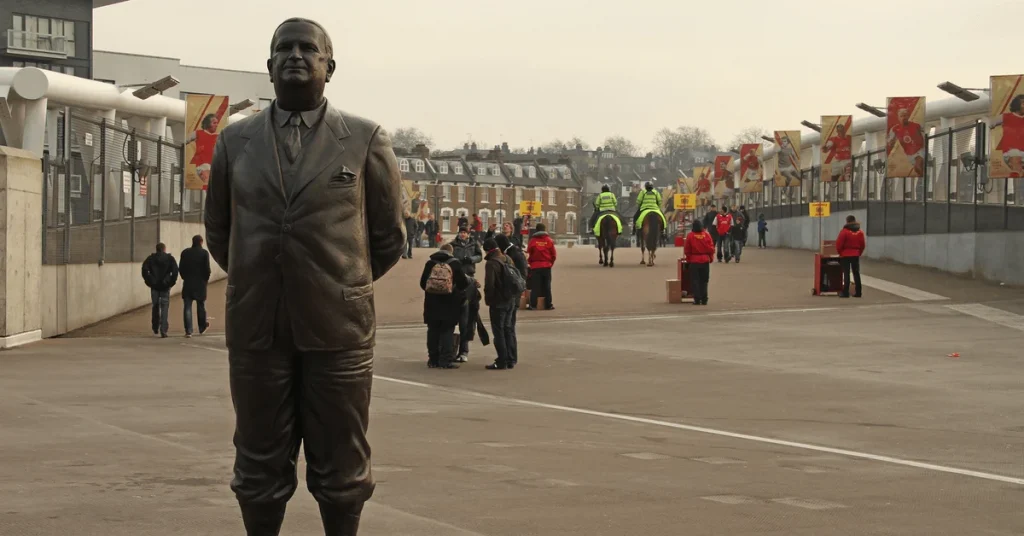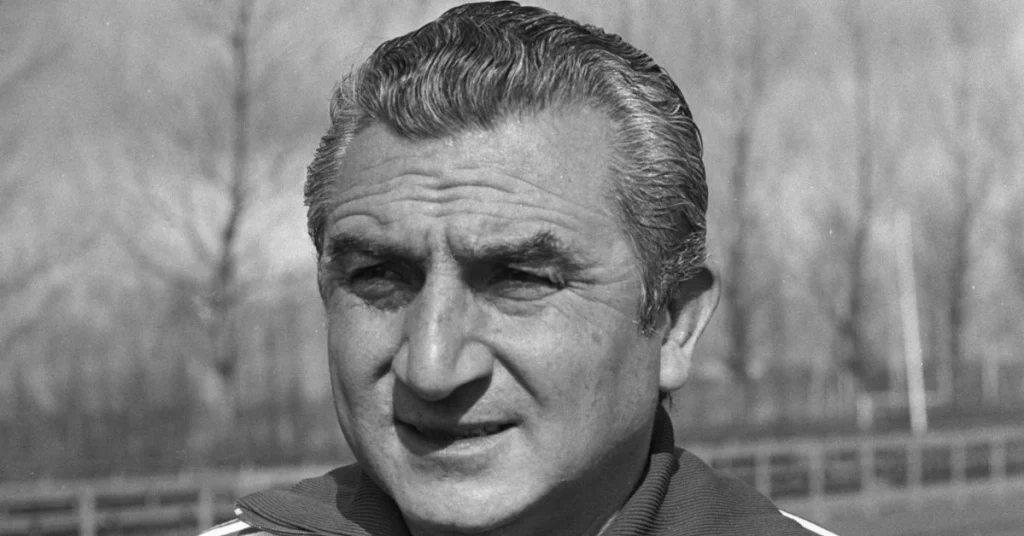Herbert Chapman is still revered by Arsenal fans almost 100 years after his death as he is credited with being the man who established them as one of the biggest clubs in England and ultimately the world. When he became their manager they went on to dominate English football in the 1930’s winning the league six times and the FA Cup twice in nine years, having won nothing before that.
He was also a great innovator, doing many things for the first time in the football world.
Herbert was born in Kiveton Park, near Rotherham in Yorkshire, in January 1878, and was one of eleven children. He began his football career as an inside forward (attacking midfield), playing for Kiveton Park, Ashton North End, Stalybridge Rovers and Rochdale (not the current League Two side) before making his Football League debut with Grimsby Town in 1898. Further moves to Swindon Town, Sheppey United and Worksop Town preceded him joining Northampton Town in 1901, with whom he turned professional for the first time.
He also played for Sheffield United and Notts County before a £70 transfer fee took him to Tottenham Hotspur, then a non-league side, in 1905. Two years later he decided to give up football and take up engineering, but his team mate Walter Bull advised him to take the vacant player manager’s job at Northampton Town. Northampton had finished bottom of the Southern League for two years running. Teams rarely used tactics in those days and Herbert soon made his mark, dropping the half backs back a bit and developing a counter attacking style of play, which was revolutionary.
They finished 8th in his first season then won the league in 1908/09 and Chapman retired from playing. That earned them a place in the Charity Shield against the Football League champions, Newcastle United, but lost 2-0. Chapman was exasperated that Northampton couldn’t get into the Football League automatically, they had to apply, and he suggested a new Third Division should be formed but the idea was rejected (it did happen in 1920). Northampton finished in the top four for three successive seasons but in 1912 he was offered the manager’s job at Leeds City, then in Division Two.
They were facing re-election but Herbert successively lobbied their case and they finished 6th in 1912/13, and gates rose from 8,500 to 13,000 as they rattled in 70 goals, the second highest in the league. They were on the up, but World War One was declared in 1914 and league football was suspended. Leeds recruited many guest players for the regional war leagues. Chapman decided to help the war effort and became manager of a munitions factory, but whilst he was away the running of the club went a bit awry.
When Chapman returned to the club in 1918 there was plenty of internal strife. One of their players, Charlie Copeland, wanted to double his weekly wage to £6 or else he would tell the League that players had received illegal payments during the war. Leeds called his bluff and sent him on a free transfer to Coventry City, but he carried out his threat in July 1919. Many clubs had transgressed in this way and no one bothered, but they were duty bound to investigate. The Leeds board were asked to show their books, but they refused and they were mysteriously destroyed in a fire! Leeds were expelled from the league and went bust, with all their officials including Herbert being banned for life!
Chapman went to work in a coke factory in Selby but in January 1920 Huddersfield wanted him as their assistant manager. That meant an appeal to the FA to overturn his ban, claiming that when the illegal payments happened, he wasn’t with the club. They agreed and lifted the ban, and by March 1921 he was the Huddersfield manager. He revolutionised their tactics with a strong defence and fast counter attacks and in 1921/22 they won the FA Cup, their first major honour. They were revitalised and finished third in 1922/23 and then won the league title in 1923/24. It was by what is still the narrowest margin ever, a goal difference of .024 over Cardiff City who missed a penalty on the final day and only drew 0-0 whereas Huddersfield won 3-0, the third goal being crucial.
They retained their title in 1924/25 with their defence being the key as they were the first team to win the league without conceding more than two goals in any game. In the 1925 close season. Herbert spotted an advert in the newspaper for the position of team manager at Arsenal and he applied, having always wanted to work in London.
It was a surprise, as in those days Arsenal were nothing like as big a club as they are nowadays. They had finished 20th in Division One the previous season, had spent half of their existence (nearly 40 years) in Division Two, never won anything and had only finished as high as sixth in the top flight once. The salary though was £2,000 a year, double his Huddersfield remuneration, whilst top players of the day were paid £300 a year.
The offside law was changed in July 1925 from three defenders needed to be between the player and the goal to two and Chapman embraced the change, moving his centre half to the centre of the defence, forming a WM formation as it looked, a 3-2-2-3. He made some astute signings including the experienced Charlie Buchan from Sunderland.
He set about drumming his style into the players and they went on to finish second in the league in 1925/26, their highest ever finish, ironically behind his former club Huddersfield, who thus became the first team to win the league in three successive seasons.
They reached the FA Cup Final in 1927, only to lose 1-0 to Cardiff City, but also that year the club were charged with making illegal payments to the aforementioned Buchan. Chapman was absolved of any blame and the chairman Sir Henry Norris carried the can and he was banned for life. Chapman’s influence on Arsenal saw him assume control of all team matters which was a bit unusual as most clubs’ teams were picked by the directors.
He was a strong believer in physical fitness and introduced a strict regime with physiotherapists and masseurs, again revolutionary. Chapman also became the first man to pay a £10,000 transfer fee when he signed David Jack from Bolton Wanderers in 1928.
When he arrived in 1925, he announced a five-year plan to become a top side and in 1930 they duly won their first trophy, defeating Huddersfield 2-0 in the FA Cup Final. It was Chapman’s idea to have both teams walk out side by side, a tradition that has continued to the present day. He tried to sign Rudy Hiden, an Austrian goalkeeper, but was turned down by the Players Union and the Football League although he did manage to sign Gerard Keyser, the first Dutchman to play in English football.
In the 1930/31 season they won the Division One title for the first time, scoring 127 goals which is still a club record. Chapman was involved with everything to do with Arsenal and even helped to design the new West Stand at Highbury and it was his idea to have a huge clock on the south terrace to help fans know how long was left in a game, which became known as the Clock End.
He also told his players to clap all four sides after a game to thanks the supporters and introduced hoops on their stockings as he thought it would be easier for players to spot each other when looking down.
In 1931/32 Arsenal finished second in the league and runners up in the FA Cup Final, losing to Newcastle United. They also played a series of friendly games against overseas clubs and floated the idea of a European Cup, but it was dismissed by the authorities until the 1950’s.
He also advocated floodlights for night games having witnessed one in Belgium and had them installed at Highbury but the powers that be refused for them to be used, another innovation delayed until the 1950’s!
Other things he got his teeth into was revamping the ticketing system to that similar to the underground and he also got the name changed of the nearest tube station from Gillespie Road to simply Arsenal. He said “Whoever has heard of Gillespie Road? They have all heard of Arsenal!” It is the only tube station named after a football club, and is near the new Emirates Stadium.
In 1932/33 Arsenal won the league again and were now being talked about as the best team in the country, despite losing to Walsall in the FA Cup, one of the greatest ever shocks. Chapman blew a fuse and sold two of his team within two weeks of the game. During the 1933 close season he became the first professional manager to take charge of England on an overseas tour, although he had no input in choosing the team, it was done by a committee, something that lasted until Alf Ramsey took over in 1963.
In 1933/34 Chapman had the idea of changing the Arsenal strip from all red shirts to red shirts with white sleeves after spotting someone in the crowd wearing a red sleeveless sweater over a white shirt. It was adopted and is obviously still their present strip today. On New Years Eve 1933 Arsenal were four points clear at the top of the league after a 0-0 draw at Birmingham City, but that tragically proved to be Herbert’s last game in charge.
On New Years Day, he went on a scouting mission to watch Bury play Notts County, then saw Sheffield Wednesday, Arsenal’s next opponents, play Birmingham.
He returned to London nursing a cold but watched Arsenal’s third team play Guildford City. Overnight the cold turned to pneumonia and in the early hours on 6 January he sadly died aged just 55. Four days later he was buried in St Mary’s Churchyard in Hendon. Arsenal went on to win the league in 1933/34 and 1934/35 to emulate Huddersfield’s hat trick and they also won the FA Cup again in 1936.
His legacy has never been forgotten. There was a marble bust of him in the entrance hall at Highbury, which is now at the Emirates Stadium, and on 9 December 2011, a statue of Herbert was unveiled outside the new stadium as part of the club’s 125th anniversary. He will never be forgotten, and was a very important part of Arsenal and football’s history.





